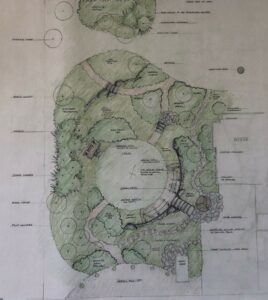Lucy & Kean Ivey, 1000 Lyndhurst Rd, Waynesboro, VA
Parking: Our address is 1000 Lyndhurst Road, and the Moon Garden borders Lyndhurst and the alley just parallel to Lyndhurst on the southeast. Because there is no parking on Lyndhurst, you will need to park either (1) in our driveway (2 or 3 spaces), which is the first on the right in the alley off Windsor, or (2) in our pulloff just beyond the driveway, which is next to the greenhouse. Otherwise, you can park on Woodrow Ave, which is one block southeast of Lyndhurst and walk up. Please don’t park in or block neighbors’ driveways or in their yards!
About:
The Ivey Moon Garden was designed and built over the summer of 2018 and is now in its sixth summer of growth. While it has always been a landscape of plants that can handle full sun and mostly clay soil, a wet-weather swale and depression were built into the landscape to afford some variety of plantings, and boulders were installed and different levels created to add flow and interest to what had previously been a flat yard.
The original plantings included some 210 trees and shrubs, 511 grasses and sedges, and 400 perennials. I can say with certainty that most of the trees and shrubs are still thriving where they were planted; the rest is like a new painting every year: What was successful in one bed one year may not show up the next year, but I may find it another year in another part of the garden altogether, or even carried by birds over into the fenced garden by the house.
This year, the second year of drought, has brought a dramatic decrease in the number and/or size of flowers and/or periods of flowering. And for the first time ever, deer found their way into the Moon Garden, stripping bare all the Smooth Aster (Symphyotrichum laeve), Obedient Plant (Physostegia virginiana), and Queen of the Prairie (Filipendula rubra) and leaving some bare dirt grazing paths where the sun could get in and bake the plants from the bottom up. Other than on those paths, what you will see, apart from very few flowers except from the toughest of the plants, are six-year-old plants that are weathering the drought with fair resistance by retaining full foliage and thus shielding their roots and lower stems from desiccation and browning.
A word on watering: I have watered first-year plantings and second-year trees, plus plants in pots and plants right around the water bowls in the garden, set out as part of its animal-habitat status. I have also watered the swale to give the water-loving plants a chance, but it’s not been enough to get any of those plants to flower.
Plants That You Will Likely See During Your Visit:
Canada Goldenrod, Purple Coneflower, Brown-eyed Susan, Smooth Blue Aster, Hollow Joe Pye Weed, Purple Passionflower, Coral Honeysuckle, last of Rattlesnake Master, last of Yarrow, Wrinkleleaf Goldenrod, Aromatic Aster, Clustered Mountain Mint, last of Shrubby St. John’s Wort, last of Slender Mountain Mint, Common Boneset, last of New York and Upland Ironweed, last of Wild Quinine, Cardinal Flower, Royal Catchfly (a prairie native but thrives in this prairie-like habitat), Wild Petunia, Cutleaf Echinacea, Nodding Onion, Cup Plant, Virgin’s Bower, and White Wood Aster. In addition there a number berries, fruits, interesting seedheads, and grass inflorescence to look out for, including the berries of Black and Red Chokeberry, last of Dewberry, Fringe Tree, Wild Raisin, and Virginia Creeper (toxic); the fruits of Muscadine, Passionfruit, and Winesap (not native, but early colonial); the seedheads of Thimbleweed, and Gray Conehead (not native); and the inflorescence of River Oats, Little Bluestem, Purple Love Grass, and Indian Grass.




